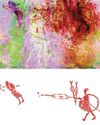
THE WORLD'S WILD LION population is in grave danger. There are only 600 Asiatic lions remaining, all of which live in a wildlife reserve in the Gir Forest in northwest India. And just 23,000 African lions roam the land between the southern edge of the Sahara and northern South Africa. The total number of wild lions worldwide has dropped by more than 40 percent in the last half century. But in the past, lions were among the most geographically widespread animals on Earth. Each ancient culture that encountered lions had its own way of embracing their power, and the big cats became symbols of spirituality, kingship, bloodlust, divinity, and even safety and peace.
RITUALS
Spain
More than 15,000 years ago, a group hunter-gatherers in northern Morf of Spain killed a lion and brought it home. Cave lions (Panthera spelaea) had roamed Europe for at least 400,000 years, but by this time, their numbers were declining as they were forced to compete for prey with an increasing human population. The lion must have been a great prize. Rather than cut up the feline for food at their cave's entrance, as they did with their other prey, the people carried parts of the huge animal 425 feet into the cave, now called La Garma, to an area known as the Lower Gallery. There, archaeologists discovered nine of the animal's phalanges, the part of the paw to which the claws are attached.
The faunal remains in La Garma's Lower Gallery are uniquely well preserved and provide rare evidence of the daily lives of Paleolithic hunter-gatherers and of the animals they interacted with. More than 4,000 mammal bones and fragments have been uncovered in the Lower Gallery, but none more fascinating than the lion's.
This story is from the September/October 2023 edition of Archaeology.
Start your 7-day Magzter GOLD free trial to access thousands of curated premium stories, and 8,500+ magazines and newspapers.
Already a subscriber ? Sign In
This story is from the September/October 2023 edition of Archaeology.
Start your 7-day Magzter GOLD free trial to access thousands of curated premium stories, and 8,500+ magazines and newspapers.
Already a subscriber? Sign In

A Very Close Encounter
New research has shown that human figures painted in red on a rock art panel in central Montana depict individuals engaged in a life-or-death encounter during an especially fraught historical moment.

A Sword for the Ages
A zigzag pattern, now tinged with the green-blue patina of oxidized metal, adorns the octagonal hilt of a rare sword dating to the Middle Bronze Age in Germany (1600-1200 B.C.) that was recently excavated in the Bavarian town of Nördlingen.

Ancient Egyptian Astrology
For centuries, layers of soot have coated the ceilings and columns in the entrance hall of Egypt's Temple of Esna. Now, an Egyptian-German team of researchers, led by Hisham El-Leithy of the Egyptian Ministry of Tourism and Antiquities and Christian Leitz of the University of Tübingen, is restoring the temple's vibrant painted reliefs to their original brilliance.

BRONZE AGE POWER PLAYERS
How Hittite kings forged diplomatic ties with a shadowy Greek city-state

RITES OF REBELLION
Archaeologists unearth evidence of a 500-year-old resistance movement high in the Andes

Secrets of Egypt's Golden Boy
CT scans offer researchers a virtual look deep inside a mummy's coffin

When Lions Were King
Across the ancient world, people adopted the big cats as sacred symbols of power and protection

UKRAINE'S LOST CAPITAL
In 1708, Peter the Great destroyed Baturyn, a bastion of Cossack independence and culture

LAPAKAHI VILLAGE, HAWAII
Standing beside a cove on the northwest coast of the island of Hawaii, the fishing village of Lapakahi, which is surrounded by black lava stone walls, was once home to generations of fishers and farmers known throughout the archipelago for their mastery of la'au lapa'au, or the practice of traditional Hawaiian medicine. \"

A MORE COMFORTABLE RIDE
Although the date is much debated, most scholars believe people 5,000 years ago. For thousands of years after that, they did so without saddles. \"In comparison with horse riding, the development of saddles began relatively late, when riders began to care more about comfort and safety in addition to the horse's health,\" says University of Zurich archaeologist Patrick Wertmann.